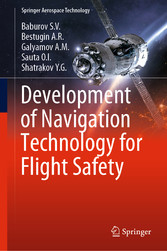Suche
Lesesoftware
Info / Kontakt
Development of Navigation Technology for Flight Safety
von: Baburov S.V., Bestugin A.R., Galyamov A.M., Sauta O.I., Shatrakov Y.G.
Springer-Verlag, 2019
ISBN: 9789811383755 , 250 Seiten
Format: PDF, Online Lesen
Kopierschutz: Wasserzeichen




Preis: 90,94 EUR
eBook anfordern 
Introduction
7
References
11
Contents
13
Abbreviations
16
1 General Description of Flight Safety Problems
18
1.1 Analysis of the State and Prospects for the Development of Instrument Landing Systems and Collision Avoidance Systems
18
1.1.1 Instrument Landing Systems
18
1.2 Features of Global Navigation Satellite Systems as an Instrument Basis for Improving Flight Safety
23
1.3 Augmentations—The Main Method to Improve the Performance Characteristics of Global Navigation Satellite Systems
33
1.4 Analysis of Requirements for Satellite-Based Landing Systems and Collision Avoidance Systems
37
1.5 General Methods and Techniques to Improve Flight Efficiency and Safety When Using Satellite-Based Landing Systems and Collision Avoidance Systems
46
1.6 Flight Safety Indicators
47
1.7 Conclusions
55
References
56
2 Methodology for Constructing Satellite-Based Landing Systems and Collision Avoidance Systems
60
2.1 Theoretical Background of a Formalized Methodological Approach to the Selection of Basic Elements for Radioelectronic Complexes to Improve Flight Efficiency and Safety
62
2.2 Methods for Building the Structure of the Ground and Onboard Radioelectronic Complexes of Satellite-Based Landing Systems with Augmentations of Global Navigation Satellite Systems
79
2.3 Methods and Rules for the Development of a Collision Avoidance System with the Use of Global Navigation Satellite System Technologies
84
2.4 Directions and Methods to Enhance Satellite-Based Landing Systems and Collision Avoidance Systems
86
2.5 Conclusions
92
References
93
3 Methods for Improving Flight Efficiency and Safety for Satellite-Based Landing Systems
95
3.1 Method for Increasing the Accuracy and Integrity of the Guidance Signals Based on the Construction and Use of Volumetric Distribution Diagrams for Radio Waves Multipath Errors and the System Structure for Its Implementation
95
3.2 Method for Ensuring Integrity and Continuity of Guidance Signals Based on the Use of an Integrated Signal-to-Noise Ratio for Pseudoranges in the Presence of Radiointerference
108
3.3 Method for Increasing Accuracy and Integrity of Guidance Signals Based on Pseudorange Error Compensation Using Phase Measurements and the Structure of the Radioelectronic Complex for Its Implementation
122
3.4 Method for Increasing Accuracy, Integrity, Continuity, and Availability of Guidance Signals Based on the Use of Pseudosatellite Signals and the System Structure for Its Implementation
127
3.5 Conclusions
133
References
134
4 Methods for Improving Flight Efficiency and Safety Based on Technologies Applicable in Collision Avoidance Systems
137
4.1 Method for Improving Flight Safety by Generating a Warning About a Potential Collision Based on the Three-Dimensional Synthesis of the Underlying Surface Sections and the Display of Hazardous Elements
137
4.2 Method for Increasing the Flight Effectiveness and Safety by Assessing the Possibility of Vertical Maneuvering and Determining the Direction of the Turn
148
4.3 Method for Increasing the Flight Effectiveness and Safety by Identifying Hazardous Terrain, Taking into Account the Possibility of a Reverse Turn, and the System Structure for Its Implementation
153
4.4 Method for Improving Flight Efficiency and Safety by Analyzing the Space Inside a Corridor Safe for Flight
166
4.5 Conclusions
174
References
175
5 Integrated Technical Solutions on the Joint Use of Technologies Applicable in Collision Avoidance Systems and Satellite-Based Landing Systems
177
5.1 Principles of Constructing an Integrated Flight Safety Enhancement System Based on the Collision Avoidance System and the Satellite-Based Landing System
177
5.2 Method for Preventing Aircraft Landings on an Unauthorized Runway by Calculating a Virtual Glide Path
181
5.3 Method for Notifying of the Aircraft or UAV Position During the Landing and Roll-on Operation
191
5.4 Assessment of Flight Safety and Efficiency Improvements with the Use of Integrated Systems
210
5.5 Conclusions
212
References
213
6 Recommendations for the Application of the Proposed Technical Solutions in the Satellite-Based Landing Systems and Collision Avoidance Systems
215
6.1 Principles of Construction and Design Features of Onboard Equipment to Improve Flight Efficiency and Safety
216
6.2 Construction of an Onboard Navigation and Landing Complex on the Basis of the Satellite-Based Landing System and the Collision Avoidance System
221
6.3 Results of the Satellite-Based Landing System Flight Tests
226
6.4 Results of the Enhanced Ground Proximity Warning System Flight Tests and Operation
233
6.5 Conclusions
242
References
243
Correction to: Development of Navigation Technology for Flight Safety
245
Correction to: Baburov S.V. et al., Development of Navigation Technology for Flight Safety, Springer Aerospace Technology, https://doi.org/10.1007/978-981-13-8375-5
245
Conclusion
246





